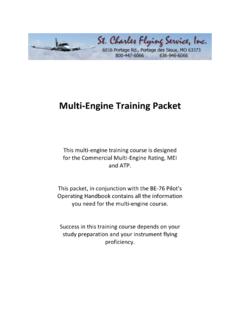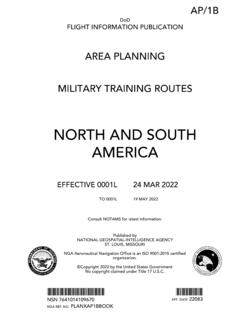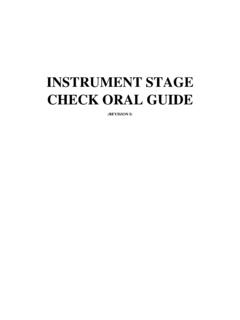Transcription of Instrument Proficiency Check (IPC) Guidance
1 Federal AviationAdministrationInstrument Proficiency Check (IPC) GuidanceInstrument Proficiency Check Guidance Table of Contents Step 1: 2 2 Regulatory 2 Cross-Country Flight Plan 2 Step 2: Ground 3 3 Taxi, Takeoff, 7 Arrival and 12 Step 3: Flight Aircraft 14 Systems 14 Step 4: Post-Flight Step 5: Instrument flying Practice 16 Personal Proficiency Practice 16 Appendix 1 CFI s IPC 18 Appendix 2 Pilot s Instrument Experience 22 Appendix 3 Personal Minimums 23 Appendix 4 3-P Risk Management 27 Appendix 5 Instrument Planning Flow 28 Appendix 6 Regional / Seasonal Factors 29 Appendix 7 Instrument Training & Proficiency 30 Appendix 8 31 ii Aug07 Instrument Proficiency Check Guidance Acknowledgements This guide has been developed with
2 Assistance, contributions, and suggestions from a number of general aviation pilots and flight instructors. Special thanks are due to Terry Brewer, Columbia Aircraft; Mike Coligny, AeroSimulators USA; Mike Gaffney, Skyline Aeronautics; Ron Galbraith, RGAviation; Mike Gilbert, Aviation Adventures; Sandy & JoAnn Hill, NAFI; Cliff Izer, Professional Aviation Services LLC; Lynn Jensen, Jensen Consulting; David Klueter; Dr. Lissa Klueter; Roger Sharp, Cessna Aircraft; Doug Stewart, DSFI; Howard Stoodley, Manassas Aviation Center; and Max Trescott, SJFlight, and members of the General Aviation Joint Steering Committee s Personal Aviation Subgroup.
3 It is intended to be a living document that incorporates comments, suggestions, and ideas for best practices from GA instructors like you. Please direct comments and ideas for future iterations to: Happy and safe flying ! iii Aug07 Instrument Proficiency Check Guidance Introduction The certificated flight instructor (CFI) performs one of the most vital and influential roles in aviation, because the aviation educator s work matters not just for the individual pilot, but for every passenger who entrusts his or her life to that pilot s knowledge, skill, and judgment.
4 The Instrument flight instructor the so-called double-eye carries an even greater responsibility. Weather is still the factor most likely to result in aviation accidents with fatalities. Notwithstanding the common reminder that the Instrument rating is not an all weather license, the CFI-I s endorsement for Instrument privileges attests that the pilot has the knowledge and skill to operate safely in Instrument meteorological conditions (IMC) during all phases of flight.
5 Two special challenges arise for the CFI-I who administers the Instrument Proficiency Check (IPC) described in 14 CFR (d). The CFI-I who trains a pilot for the initial Instrument rating can develop a comprehensive picture of that pilot s Instrument flying knowledge, skills, and judgment, usually in an aircraft familiar to both the CFI-I and the trainee. By contrast, an IPC more often requires short-term evaluation of an unknown pilot, possibly with the added challenge of an unfamiliar aircraft and/or avionics, particularly in technically advanced aircraft.
6 In addition, the IPC is not always conducted in the real-world IMC flying environment. To ensure that the IPC serves the purpose for which it was intended, the current version of the Practical Test Standards (PTS) for the Instrument rating (FAA-S-8081-4D effective October 1, 2004) stipulates that the flight portion of an IPC must include certain aeronautical tasks specific to Instrument flying . This guide offers additional (optional) Guidance , with special emphasis on conducting a thorough ground review and on administering IPCs in aircraft with advanced avionics.
7 The goal is to help the CFI-I determine that a pilot seeking an IPC endorsement has both the knowledge and skills for safe operation in all aspects of Instrument flying . This guide is also designed as a companion to the FAA s Conducting an Effective Flight Review, which offers optional Guidance to CFIs on administering the flight review required by 14 CFR 1 Aug07 Instrument Proficiency Check Guidance Step 1: Preparation Expectations: Regulations for the flight review (14 CFR ) require a minimum of one hour of ground training and one hour of flight training.
8 While 14 CFR (d) does not stipulate a minimum time requirement for the IPC, a good rule of thumb is to plan at least 90 minutes of ground time and at least two hours of flight time for a solid evaluation of the pilot s Instrument flying knowledge and skills. Depending on the pilot s level of Instrument experience and currency, you may want to plan on two or more separate sessions to complete an IPC. For pilots with little or no recent Instrument flying experience, it is a good idea to schedule an initial session in an appropriate aircraft training device (ATD).
9 Regulatory Review: The regulations (14 CFR (d)) state that an IPC must include a representative number of tasks required by the Instrument rating practical test. A thorough IPC should cover general operating and flight rules for IFR as set out in 14 CFR Part 91 and in the Aeronautical Information Manual (AIM). To make the best use of ground time, ask the pilot to review the Instrument Procedures handbook (FAA-H-8261-1A), Instrument flying handbook (FAA-H-8083-15), and Aviation Weather and Weather Services in advance of your session.
10 Remind the pilot to bring current copies of documents such as the Instrument rating PTS, FAR/AIM, charts (en route and Instrument approach procedures), Airport/Facility Directory (A/FD), and Pilot s Operating handbook (POH) or Airplane Flight Manual (AFM) for the aircraft to be used. As part of the IPC preparation process, you may want to ask the pilot to complete the IPC Prep Course available in the Aviation Learning Center at This online course lets the pilot review material at his or her own pace and focus attention on areas of particular interest.

















